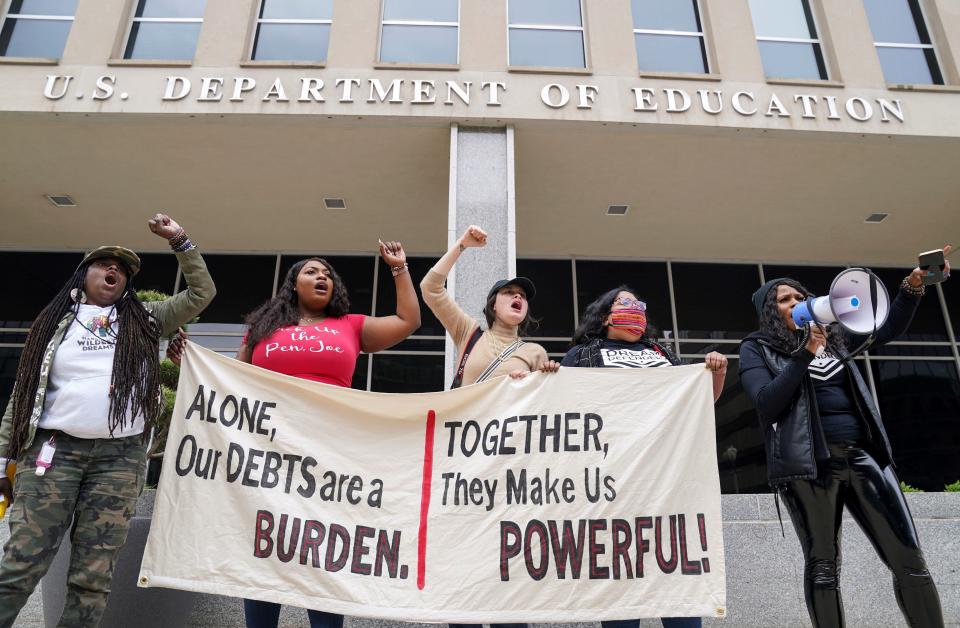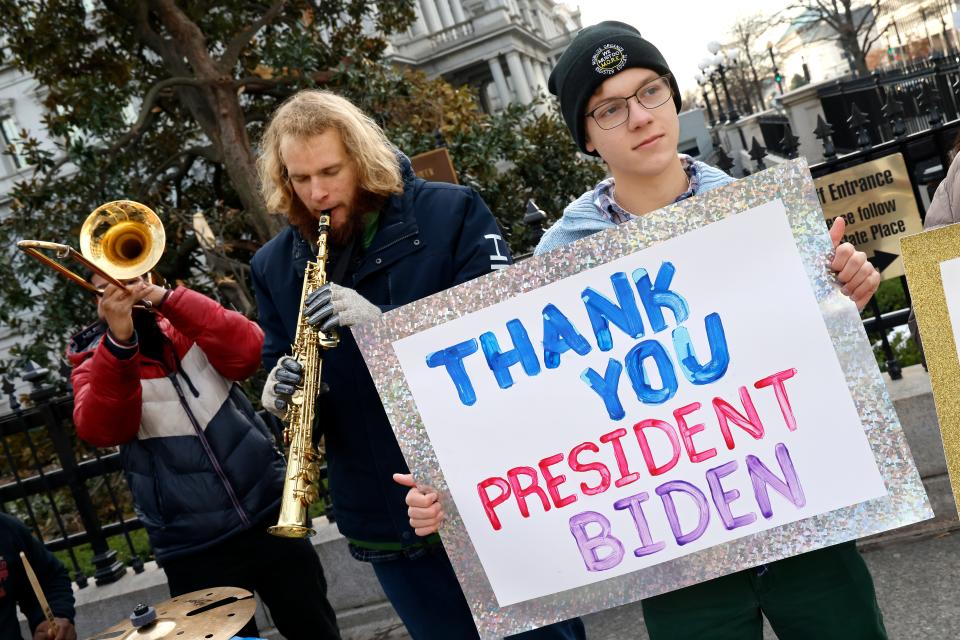Federal student loans rates have nearly doubled in past 2 years: How high they'll go
Rapidly rising interest rates are hitting consumers at every turn — and beginning July 1 those borrowing for college will feel more pain, too.
Brace yourself for a significant bump in rates on new federal student loans.
Much of the focus on student loan debt lately has been around the buzz that President Joe Biden might be on the verge of making a move to cancel at least $10,000 in federal student loan debt, which some speculate could apply to borrowers earning less than $150,000 or $300,000 for married couples.
On top of that, millions of student loan borrowers have been able to avoid making payments for nearly 2½ years under pandemic-related relief programs. Unless another extension is in the works, their payments are set to resume in September.
For those still in college, though, higher interest rates that hit this summer can't be easily overlooked.
The fixed interest rate on federal student loans will climb to 4.99% for undergraduate loans — up from 3.73% last year. The new higher rate applies to Federal Direct Stafford loans for undergraduates issued from July 1 through June 30, 2023.
Rates have nearly doubled in the past two years since the federal fixed rate for undergraduate loans had fallen to 2.75% for the 2020-21 academic year.
More from Susan Tompor: 2 Michigan women tricked by convincing, sophisticated Amazon scam: What to know
Think homes in Michigan are overpriced? You might be right.
The 4.99% rate brings borrowers close to the 5.04% rate in the 2018-19 school year.
It's important to note that you won't be paying higher rates on money you've already borrowed through federal education loans. The lower rates for those who borrowed earlier are locked into place.

The cheapest way to borrow for college is for the undergraduate student to borrow the most money they're eligible to get through federal student loans first. The undergrad qualifies for the lowest rates.
After that, rates only climb higher.
What will parents and grad students pay?
Parents and graduate students borrowing for college typically pay even higher rates and can plan to see their new rates climb much higher too.
The new fixed rate will be 6.54% for Federal Direct Stafford Loans for graduates — up from 5.28% for the previous academic year.
The fixed rate for Direct PLUS loans, which can be taken out by parents and graduate or professional students — will go up to 7.54% That's up from 6.28% for the previous academic year. It had been 5.3% for the 2020-21 academic year.
PLUS loans come with a fixed rate that's good for the life of the loan. Not everyone qualifies for a PLUS loan. A credit check is required. If you have what the Department of Education defines as an "adverse credit history" you might not qualify if you don't meet other requirements. An adverse history includes "accounts with a total outstanding balance greater than $2,085 that are 90 or more days delinquent as of the date of the credit report" and other factors.

But it's important to note that rates for Parent PLUS loans are not risk-based pricing and everyone will pay a fixed rate of 7.54% for PLUS Loans taken out from July 1 through June 30, 2023.
Hard to game the rate hikes
You might think there's maybe a way to borrow more money now if rates are going up July 1 and we've got roughly a month to go. But the strategy won't work.
College borrowing expert Mark Kantrowitz says new high school graduates and their parents cannot rush to take out loans before July 1 to lock in lower rates.
"You must be enrolled in college on at least a half-time basis at the time of borrowing to borrow student loans," he said.
"A student who will be enrolled in the fall is not enrolled now," Kantrowitz said. As a result, the student would not be eligible to borrow student loans now at that lower rate.
Why the big bump in rates?
Student loan rates — along with other interest rates — are heading higher as inflation has soared.
The average rate on a 30-year fixed mortgage is 5.27%, up from 3.16% a year ago, according to Bankrate.com.
The average rate on a five-year new car loan is 4.61% now, compared with 4.12% a year ago.
Federal student loans are pegged to the yields on the last 10-year Treasury note auction in May. The Fed made clear that it will be driving short-term rates higher to cool down red-hot inflation numbers and that has influenced the Treasury market.
The consumer price index rose 8.3% over the last 12 months through April. The data for May will be released on June 10.
Isn't everyone paying 0% now anyway?
At the beginning of the COVID-19 pandemic in March 2020, the federal government gave substantial financial relief to about 20 million college borrowers with federal student loans. Payments were suspended, a 0% rate was charged on outstanding balances and collections were stopped on defaulted loans.
Almost 60% of college borrowers — or 11.5 million borrowers — holding federal student loan debt who qualified for the pandemic freeze have not made any payments on their student loans from August 2020 through December 2021, according to data released in a May 27 report from the Federal Reserve Board of Governors.
Eliminating the student loan bill from their monthly budgets has helped many cover other expenses and even reduce other debt, such as credit card debt. The average monthly payment was $260, according to the Fed report.
"It is possible that some of these borrowers may not be ready to resume payments once forbearance expires," the Fed report stated.
The moratorium, which has been repeatedly extended, is scheduled to end Aug. 31. Repayment would need to resume in September unless another extension takes place, which some say is possible.
"It seems likely that there'll be a seventh extension, as it would be political suicide for Democrats to restart repayment two months before an election," Kantrowitz said.
Kantrowitz noted that Biden already has forgiven more than $18 billion in federal student loans in targeted initiatives that involve about 1 million borrowers under existing programs already authorized by Congress.
As of early June, it remained unknown what kind of additional loan forgiveness could be ahead.
How Fed rate hikes do and don't influence student loans
The good news for college juniors or seniors is that they locked in decent rates on earlier loans.
Federal student loans issued in recent years won't be impacted by the July increase in student loan rates or Fed rate hikes in 2022.
But a small group of people who borrowed before 2006 have variable-rate federal student loans that aren't fixed. Changes to the Fed’s benchmark rate can affect variable interest rates, according to Robert Humann, chief revenue officer for Credible.com.
And private student loan rates often aren't fixed rates and can be directly influenced by future Fed rate hikes.
"Multiple factors, including a lender’s cost of capital, and their appetite for growth, affect rates, so borrowers should expect private student loans to be slightly affected by the rising rate environment," Humann said in a statement to the Free Press.
He noted that some borrowers with good credit — scores of 720 or higher — were able to lock in rates of 5.56% on 10-year fixed private student loans during the week of May 9. That was down from 6.03% the previous week.
The 10-year fixed rates for private student loans was around 6% and the variable rate for 5-year private student loans was about 4.33% as of the week of May 23, the most current Credible data available.
What's the No. 1 tip in a time of higher rates?
"Definitely avoid variable-rate private student loans, as the interest rates have nowhere to go but up," Kantrowitz says.
The temptation might be to find a low rate in the 1% or 3% range for a variable student loan but it's key to remember that rate isn't fixed for the life of the loan. A variable rate could go higher if rates keep climbing.
"A variable rate is only an option if the borrower is going to pay off the debt in full before interest rates rise too much," Kantrowitz said.
And many will not qualify for those ultralow rates.
Borrowers should shop around and compare what rates are available to them based on their credit.
You'd also need to find out if you'd need a co-signer like a parent to get a better rate. On co-signed loans, the co-signer's credit score is used if higher than the borrower's score.
Private student loans often take one's credit score into consideration and rates will vary significantly, based on one's credit history. Some private student loan variable rates can range from around 1% to edging near 12%, based on creditworthiness.
Contact Susan Tompor via stompor@freepress.com. Follow her on Twitter @tompor. To subscribe, please go to freep.com/specialoffer. Read more on business and sign up for our business newsletter.
This article originally appeared on Detroit Free Press: Federal student loan rates increasing: Tips for borrowers

